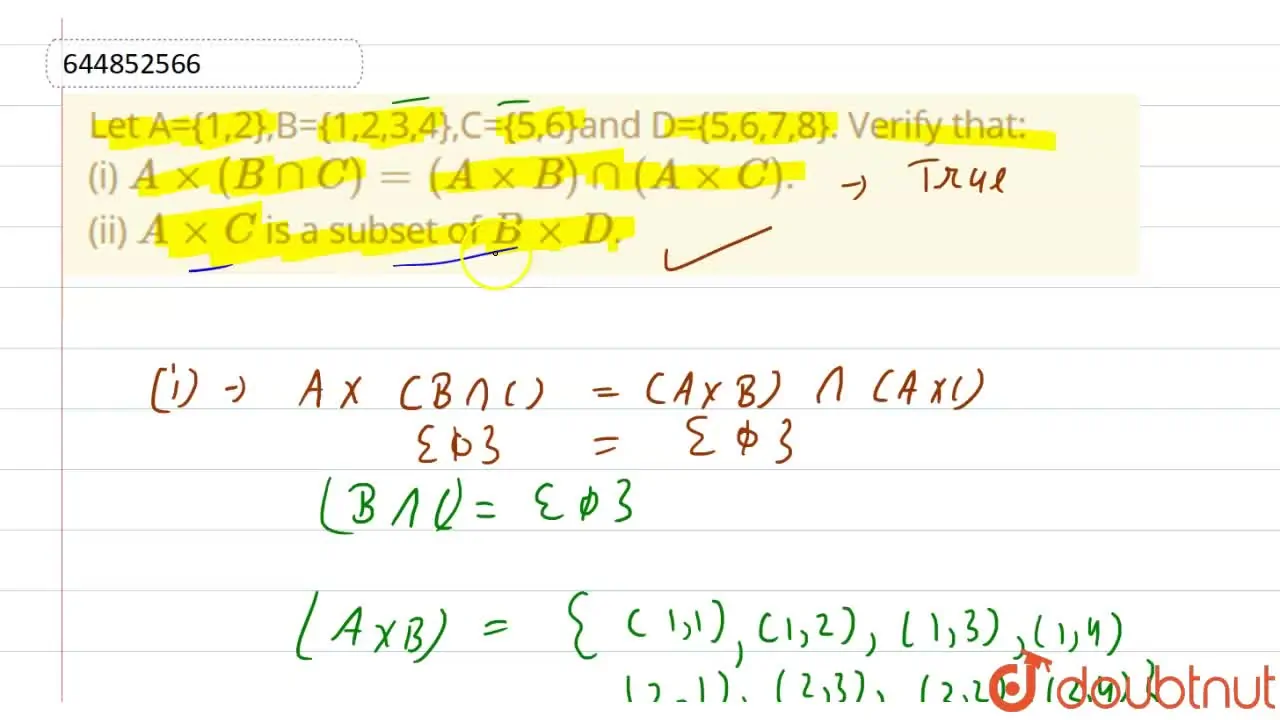Let A={1,2},B={1,2,3,4},C={5,6}and D={5,6,7,8}. Verify that:
(i) A×(B∩C)=(A×B)∩(A×C).
(ii) A×C is a subset of B×D.
The correct Answer is:N/a
(i) ∵A={1,2},B={1,2,3,4}andC={5,6}
∴A×(B∩C)=A×ϕ=ϕ
A×(B∩C)=ϕ ...(1)
Now, A×B={(1,1),(1,2),(1,3),(1,4),(2,1),(2,2),(2,3),(2,4)}
and A×C={(1,5f),(1,6),(2,5),(2,6)}
∴(A×B)∩(A×B)=set of common elements of (A×B)and(A×C)=ϕ
∴(A×B)∩(A×C)=ϕ ...(2)
Then, from equation (1) and (2) ,
A×(B∩C)=(A×B)∩(A×C) hence Proved.
(ii)∵=A={1,2},B={1,2,3,4},C−{5,6},D={5,6,7,8}
then A×C={(1,5),(1,6),(2,5),(2,6)}...(1)
and B×D={(1,5),(1,6),(1,7),(1,8),(2,5),(2,6),(2,7),(2,8),(3,5),(3,6),(3,7),(3,8),(4,5),(4,6),(4,7),(4,8)}
Clearly , all ordered pair of A×C are in B×D.
Therefore , A×C is a subset of B×D. Hence Proved.
Related Playlists
- BOOK - NAGEEN PRAKASHAN ENGLISHCHAPTER - RELATIONS AND FUNCTIONSEXERCISE - Exercise 2.29videos
RELATIONS AND FUNCTIONS
- BOOK - NAGEEN PRAKASHAN ENGLISHCHAPTER - RELATIONS AND FUNCTIONSEXERCISE - Exercise 2.35videos
RELATIONS AND FUNCTIONS
- BOOK - NAGEEN PRAKASHAN ENGLISHCHAPTER - RELATIONS AND FUNCTIONSEXERCISE - Exercise 2 G10videos
RELATIONS AND FUNCTIONS
- BOOK - NAGEEN PRAKASHAN ENGLISHCHAPTER - PROBABILITYEXERCISE - MISCELLANEOUS EXERCISE10videos
PROBABILITY
- BOOK - NAGEEN PRAKASHAN ENGLISHCHAPTER - SEQUENCE AND SERIESEXERCISE - Miscellaneous Exercise32videos
SEQUENCE AND SERIES
Similar Questions
Let A={1,2}, B={1,2,3,4}, C={5,6}and D={5,6,7,8} . Verity that: A×(B∩C)=(A×B)∩(A×C)
View SolutionLet A={1,2}, B={1,2,3,4}, C={5,6}and D={5,6,7,8} . Verity that: A×C⊂B×D
View SolutionLet A={1,2}.B={1,2,3,4},C={5,6}and D={5,6,7,8}. Verify that(i) A×(B∩C)=(A×B)∩(A×C). (ii) A×CisasubsetofB×D.
View SolutionLet A={1,2),B={1,2,3,4},C={5,6} and D={5,6,7,8} verify that
A×C is a subset of B×D.View SolutionIf A={1,4}B={2,3,6} and C={2,3,7} verify that A×(B−C)=(A×B)−(A×C).
View SolutionIf A={1,4},B={2,3,6} and C={2,3,7}, then verify that A×(B∪C)=(A×B)∪(A×C)
View SolutionIf A={1,4},B={2,3,6} and C={2,3,7}, then verify that A×(B∩C)=(A×B)∩(A×C)
View SolutionIf A={2}, B={5}, C={3,4,6}, then verify that A×(B∩C)=(A×B)∩(A×C).
View SolutionLet A={1,2},B={1,2,3},c={5,6}andd={5,6,7} verify that
A×C is a subset of B×DView SolutionLet A={1,2,4,5} B={2,3,5,6}C={4,5,6,7} . Verify the following identities: A−(B∪C)=(A−B)∩(A−C)
View Solution


